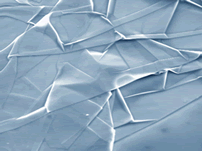GRAPHENE
[Property Sheet] [Price Sheet] [FAQ]
Property Sheet
| Property |
typical value
parallel to surface |
typical value
perpendicular to surface |
Unit of Measure |
| Density |
2.2 |
2.2 |
grams/cc |
| Carbon Content |
> 99.5 |
> 99.5 |
percent |
| Thermal Conductivity |
3,000 |
6 |
watts/meter-K |
| Thermal Expansion (CTE) |
4-6 X 10 (-6) |
0.5-1 X 10 (-6) |
m/m/deg-K |
| Tensile Modulus |
1,000 |
n/a |
GPa |
| Tensile Strength |
5 |
n/a |
GPa |
| Electrical Conductivity |
10 (7) |
10 (2) |
siemens/meter |
DIMENSIONS
| X - Y (um) |
THICKNESS (nm) |
| < 1 |
< 1 |
| < 5 |
< 1 |
| < 14 |
< 10 |
| < 50 |
< 100 |
| < 10 |
< 100 |
| < 5 |
< 100 |
There are a wide range of platelet lengths (1-20um) and thickness' (~0.34 to 100nm) Single layer graphene as thin as 0.34nm
[Property Sheet] [Price Sheet] [FAQ]
Price Sheet
GRAPHENE NANOPLATELETS
Graphene ships as dry granules or powder. Each grade contains particles with an average thickness and surface area
Grade M (~ 5 - 8nm thickness, typical surface area of 120 - 150 m(2)/g)
| product |
100 g |
500 g |
1-10 kg |
11-100 kg |
| order unit |
100g lot |
500g lot |
Kg |
Kg |
| M-5 |
$99.00 |
$249.00 |
$299.00 |
$229.00 |
| M-15 |
$99.00 |
$249.00 |
$289.00 |
$219.00 |
| M-25 |
$99.00 |
$249.00 |
$289.00 |
$219.00 |
Grade H (~ 11 - 15 nanometers thick, surface area 60 - 80 m(2)/g)
| product |
100 g |
500 g |
1-10 kg |
11-100 kg |
| order unit |
100g lot |
500g lot |
Kg |
Kg |
| M-5 |
$99.00 |
$199.00 |
$179.00 |
$135.00 |
| M-15 |
$99.00 |
$199.00 |
$169.00 |
$129.00 |
| M-25 |
$99.00 |
$199.00 |
$169.00 |
$129.00 |
Grade C (aggregates of sub-micron particles, surface area can be selected at 300, 500, 750 m(2)/g)
| product |
100 g |
500 g |
1-10 kg |
11-100 kg |
| order unit |
100g lot |
500g lot |
Kg |
Kg |
| C-300 |
$99.00 |
$199.00 |
$189.00 |
$169.00 |
| C-500 |
$99.00 |
$219.00 |
$199.00 |
$179.00 |
| C-750 |
$99.00 |
$219.00 |
$209.00 |
$199.00 |
Prices based on minimum 5 kg. orders.
* Prices subject to change without notice.
[Property Sheet] [Price Sheet] [FAQ]
FAQ
 Q: What exactly is graphene? Q: What exactly is graphene?
A: Graphene is a member of the class of 2 dimensional materials consisting of hexagonal arrays of sp2 – bonded carbon atoms. Its thickness is only one (1) atom. It would take over one million sheets of graphene laying on top of each other to make a thickness of (1) one millimeter.
Q: Why is graphene useful?
A: Graphene has an extraordinary lot of uses in a variety of fields. It has many amazing properties. One is that it is highly conductive (up to ~ 5,300 w/mk) which makes it five times more conductive that copper while being four times less dense. It also has exceptional in-plane conductivity (up to ~ 20,000 s/cm). Another is that it is extremely strong and has been measured to be three to five times stronger and 200 times more durable than steel. Also, graphene is very flexible. Its elastic stiffness is 340-690 n/m and can withstand 20-30% deformation. Graphenes’ two dimensional hexagonal properties give it a multitude of potential uses such as in transistors, transformers, gas sensors, inert coatings and L-Ion batteries.
Q: Who uses graphene?
A: Graphene can be used by multiple industries for multiple applications. It can be used in the Aerospace, Automotive, Computer, Defense, Energy, Semiconductor and Telecommunication industries to name a few.
Q: What does graphene look like?
 A: Graphene can come in many shapes and sizes. Today, the most common versions of graphene are small wafers, powder and long nanosheet platelets. A: Graphene can come in many shapes and sizes. Today, the most common versions of graphene are small wafers, powder and long nanosheet platelets.
Q: What uses does it have in the semiconductor industry?
A: The discoverers of graphene have been able to create a transistor. It is believed that because graphene is 98% see through, and highly conductive, it could help in making solar panels generate more electricity. Due to its hexagonal shape, graphene should be able to create even smaller devices, which in turn could be the beginning of superfast computers that need very little power.
Q: How far along are they in making this commercially feasible?
A: Although originally discovered in 2004, scientists are improving the potential technology by leaps and bounds. Originally, it was very expensive to produce even a piece of graphene that was barely a centimeter long. In 2011, sheets that are 760 cm diagonal are being commonly produced. It should also be noted that graphene has been produced via chemical vapor deposition on substrates such as silicon, copper and nickel to name a few. It is believed that single layer coating of graphene will be within the next ten (10) years with commercial applications commonly increasing during that time. |

